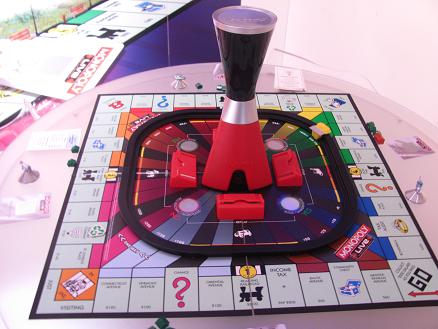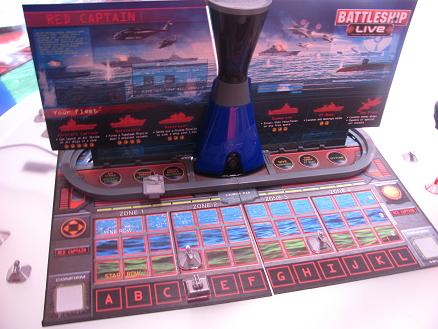Welcome to Purple Pawn, covering games played around the world by billions of people every day.
A Closer Look at Monopoly Live and Battleship Live
20 Feb
Posted by David Miller as Modern Board Games
 When word of these two new games leaked ahead of the show, my initial reaction, like that of many others I read online, was quite negative. However, now that I’ve actually had a chance to play with them a little at Toy Fair, my opinion has changed some.
When word of these two new games leaked ahead of the show, my initial reaction, like that of many others I read online, was quite negative. However, now that I’ve actually had a chance to play with them a little at Toy Fair, my opinion has changed some.
Both Monopoly Live and Battleship Live employ what Hasbro calls “motion vision technology,” or in other words, electronic tower doohickeys that can speak, sense the position of game pieces, detect hand motions, track game states, announce events, and record player choices.
In Monopoly Live, the device takes care of rolling dice, acting as the banker, and tracking each player’s cash. It also announces mini-game type events, not randomly, but actually based on the pace of the main game. For example, if the game is slowing down, the device might announce a horse race and give all the players a chance to bet on the results. For some events, the results are determined by players flicking a little taxicab figure around a track that circles the inside of the board. Other elements of the game include more player choices, as well. When purchasing the Electric Company, a player may choose the green option, which costs more up front but reduces taxes later and allows them to charge more for rent. If, when presented with the option, a player chooses to give charity, that player will earn good karma, which will benefit them on future die rolls and events. The electronic helper also provides the option to run a 30 minute quick-playing version of the game, where all properties are auctioned off at the start.
According to Hasbro, Monopoly Live is intended to play more like a game show than the traditional board game. In that, I think they have succeeded. For those players, however, that like strategy, decision making, and even dice rolling in board games, this probably goes in the wrong direction.

In contrast, though, I think Battleship Live adds a lot to the original game. In this case, the electronic device and other enhancements give the game a more modern feel, like commanding a fleet with computers and advanced weapons. In addition to the standard selection of combat ships, players have access to guided missiles, spy planes, and other new features. The electronic device at the center of the board tracks ship locations (which should minimize cheating) and announces events like typhoons and ammunition shortages. The computer asks for confirmation of each order, which is accomplished by placing both hands on designated panels on either side of the board.
Of course, there are some changes that fans of the classic game might not appreciate. Mostly gone is the letter-number grid on which ships were placed. Instead, ships are placed in columns (single-dimension hidden placement versus 2-D) and can take a certain number of hits each before sinking. Overall, though, I’d have more fun playing this one than the original.

Both Monopoly Live and Battleship Live should be available in the fall at a suggested retail price of $50.
No Comments
Sorry, the comment form is closed at this time.
Trending
- Massdrop.com
- Oh the Irony—Illuminati Card Game Continues to Inspire Conspiracy Theorists
- Home
- Footprints, an Educational Ecology Game
- USPS Adds Board Game Flat Rate Box
- Baila, the Estonian Drinking Card Game
- Crystal Caste Wins Dice Patent Suit Against Hasbro
- Mirror Game, Red and Blue
- Hasbro and Mattel Merger?
- Are Board Games Dangerous?
Archives
Most Popular Articles
- Oh the Irony—Illuminati Card Game Continues to Inspire Conspiracy Theorists
- The 20 Most Valuable Vintage Board Games
- The Truth About Dominoes On Sunday in Alabama
- Sequence Game, and Variants
- USPS Adds Board Game Flat Rate Box
- Baila, the Estonian Drinking Card Game
- The 13 Most Popular Dice Games
- Are Board Games Dangerous?
- Guess Who? The Naked Version
- What Happened to the Jewel Royale Chess Set?
Recent Posts
- Toy Fair 2019—Breaking Games
- Talisman Kingdom Hearts Edition
- Toy Fair 2019—Winning Moves
- Toy Fair 2019—Games Workshop
- Toy Fair 2019—Star Wars Lightsaber Academy
- Toy Fair 2019—Stranger Things Games
- Toy Fair 2019—HABA
- Licensing Roundup
- Game Bandit
- 2018 A Difficult Year For Hasbro But Not For D&D Or MtG
Recent Comments
- on Toy Fair 2019—Winning Moves
- on Game Bandit
- on Second Look—Dungeons & Dragons Waterdeep Dragon Heist
- on Crowdfunding Highlights
- on Beyblade SlingShock
- on Game Bandit
- on Game Bandit
- on Watch This Game!, the Board Game Review Board Game
- on Second Look—Vampire: The Masquerade 5th Edition
- on Palladium Books Loses Robotech IP License, Cancels Five-Year-Overdue Robotech RPG Tactics Kickstarter




